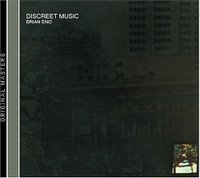Misc. Monday Song (12.19.05)
 Artist: Brian Eno
Artist: Brian EnoSong: Discreet Music (31:34)
Album: Discreet Music
Download here.
Briefly: Brian Eno is, to me, one of the most fascinating figures in music, from his early days with Roxy Music, to more or less creating ambient music, to producing albums by the likes of David Bowie and Talking Heads. Discreet Music is his first fully realized ambient work.
Why?: I can try to describe this all I want, but the only way to truly understand and appreciate "Discreet Music" is to listen to it in its entirety. It's more or less made up of a few bars of music, repeated over and over again, for 30 minutes. That sounds boring. And, well, I suppose it is boring. It's not party music. It's not driving music (unless you want to fall asleep at the wheel). But for me, there's nothing better to take the hustle and bustle out of riding the L train home after a busy day. Or for trying to fall asleep. Or to accompany reading. Its purpose, after all, is for you to hear it without really noticing it. Eno has described it as music that can be "actively listened to with attention or as easily ignored, depending on the choice of the listener."
Further listening:
Ambient 1: Music For Airports by Brian Eno
Another Green World by Brian Eno
There are no lyrics, and since I can't really get my head around how to explain the process of making this music, here are Eno's liner notes to the album from 1975:
"Since I have always preferred making plans to executing them, I have gravitated towards situations and systems that, once set into operation, could create music with little or no intervention on my part.
That is to say, I tend towards the roles of the planner and programmer, and then become an audience to the results.
Two ways of satisfying this interest are exemplified on this album. "Discreet Music" is a technological approach to the problem. If there is any score for the piece, it must be the operational diagram of the particular apparatus I used for its production. The key configuration here is the long delay echo system with which I have experimented since I became aware of the musical possibilities of tape recorders in 1964. Having set up this apparatus, my degree of participation in what it subsequently did was limited to (a) providing an input (in this case, two simple and mutually compatible melodic lines of different duration stored on a digital recall system) and (b) occasionally altering the timbre of the synthesizer's output by means of a graphic equalizer. It is a point of discipline to accept this passive role, and for once, to ignore the tendency to play the artist by dabbling and interfering. In this case, I was aided by the idea that what I was making was simply a background for my friend Robert Fripp to play over in a series of concerts we had planned. This notion of its future utility, coupled with my own pleasure in "gradual processes" prevented me from attempting to create surprises and less than predictable changes in the piece. I was trying to make a piece that could be listened to and yet could be ignored... perhaps in the spirit of Satie who wanted to make music that could "mingle with the sound of the knives and forks at dinner."
It is a point of discipline to accept this passive role, and for once, to ignore the tendency to play the artist by dabbling and interfering. In this case, I was aided by the idea that what I was making was simply a background for my friend Robert Fripp to play over in a series of concerts we had planned. This notion of its future utility, coupled with my own pleasure in "gradual processes" prevented me from attempting to create surprises and less than predictable changes in the piece. I was trying to make a piece that could be listened to and yet could be ignored... perhaps in the spirit of Satie who wanted to make music that could "mingle with the sound of the knives and forks at dinner."
In January this year I had an accident. I was not seriously hurt, but I was confined to bed in a stiff and static position. My friend Judy Nylon visited me and brought me a record of 18th century harp music. After she had gone, and with some considerable difficulty, I put on the record. Having laid down, I realized that the amplifier was set at an extremely low level, and that one channel of the stereo had failed completely. Since I hadn't the energy to get up and improve matters, the record played on almost inaudibly. This presented what was for me a new way of hearing music - as part of the ambience of the environment just as the colour of the light and the sound of the rain were parts of that ambience. It is for this reason that I suggest listening to the piece at comparatively low levels, even to the extent that it frequently falls below the threshold of audibility."

0 Comments:
Post a Comment
<< Home